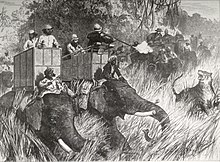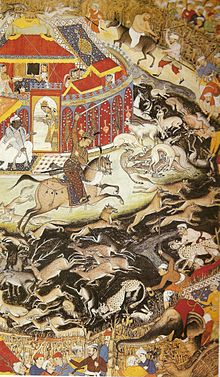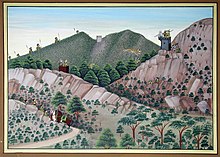
Shikargah (Hindi: शिकारगाह śikārgāh), from Persian shikārgāh meaning shikār hunting + gāh ground, is often described as a hunting ground where 'qamargah' or encircling of game occurs, an overtone of war exercise performed within a controlled arena of flora and fauna to create easier shooting and camping for hunting party.
The Mughals, who already had a hunting tradition in Central Asia, brought the practice to India upon their conquest of the subcontinent. On such occasions unresolved matters of courts were settled which included conspiration and preparation for mutinying, raising of invasion forces.


The British continued to entertain their dignitaries with elaborate tiger hunts famously known as "hunting party" at these Shikargah.

Jim Corbett National Park established in 1932 was first Shikargah turned into a national park during British India, only 40,000 tigers were left during India's independence in 1947, the first-ever all-India tiger census conducted in 1972 revealed the existence of only 1,827 tigers. Realizing the gravity of dwindling number of seven major big cats of the world — tigers, lions, leopards, snow leopards, pumas, jaguars and cheetahs, Indian Govt enacted Wild Life (Protection) Act, 1972. As of December 2024, there are 57 protected areas that have been designated as tiger reserves. , among which important tiger reserves where the numbers are more than 100 in each respectively are Corbett, Rajaji, Pilibhit, Dudhwa, Bandhavgarh, Nagarhole, Mudumalai, Kaziranga, Sunderbans and Bandipur.
Today India boasts 104 national parks, 551 Wildlife Sanctuaries, 131 Marine Protected Areas, 18 Biosphere Reserves, 88 Conservation Reserves (57 Tiger Reserves) and 127 Community Reserves, covering a total of 1,65,088.57 sq km. In total, there are 870 Protected Areas which make 5.06% of the geographical area of the country where 3,682 big cats are estimated ranking India with topmost share of 75% worldwide in 2022.
Chronicled Shikargah
Terrorizing wild beasts were often tamed by Mughals who considered themselves as protectors of people, sources record over seventy shikargahs situated in mountainous forests, deserts, Indo-Gangetic floodplains, rocky outcrops, and coastlands.

- Agra Shikargah, Uttar Pradesh
- Ajmer Ana Sagar Lake, Nur Chashma Shikargah, Rajasthan
- Burhanpur Bagh-i Zaynabad Shikargah, Madhya Pradesh
- Hissar-i-Firuza Shikargah, Haryana
- Narwar Shikargah
- Pakpattan Shikargah Pakistan
- Mahemdavad Shikargah Ahmedabad, Gujrat
- Palam, Delhi Shikargah, New Delhi
- Sheikhupura (Jahangirpur/Jahangirabad) Shikargah, Lahore, Pakistan
Earliest attempt of conservation of Shikargah


Shikargah Weave

In Popular Culture
In movie The Deceivers (film) (1988), the hunting party scene includes the phrase: "There is no greater pleasure than the hunt, for it reveals the essence of life and death." This line reflects the cultural and philosophical undertones of the film, which explores themes of deception, power, and morality in colonial India.
Gallery








Notes
- Abu’l-Fazl, Ain-i-Akbari, vol. 1, 297 mentions Simawali, Samugarh, Dahra, Jalesar, Rupbas, Bari, Somauli, Alapur, Simawali, Bhatinda, Sunnam, and Bhatnir as favoured shikargahs and manzil-gahs near Agra; The Bayaz-i khwushbu’i, a seventeenth century handbook for Mughal noblemen, mentions Dahra Bagh as a hunting garden where Mughal emperors encamped and hunted on numerous occasions, and which was frequented by Jahangir.
- Mundy, Sketches, pages:37–41, 48–51; Mundy mentions shikargahs in the vicinity of major cities such as Lucknow (37–41), Fatehgarh (48–51), and Belaspore (73). Captain Mundy recorded the above facts during Governor General Henry Hardinge's pre-1857 tennure, the biggest tiger hunt which has not been met since 1911 was done by Henry Hardinge's grandson Lord Hardinge then Viceroy of India (1910-1916), who shot a tiger than measured 11 feet and 6 inches.
- A painting attributed to Nanha portrays Jahangir and Rana Karan of Mewar 1615, at Anasagar c.1623, R316/S.163
- Bailey, ‘Sweet-Smelling Notebook’, pages:132–33 mentions Jahangir hunting regularly in the favored Nur Chashma (Hafiz-Jamal) hunting garden near Ajmer; See Jahangir, Tuzuk, vol. 1, pages:182, 232, 234, vol. 2, pages:75–76. ; Jahangir, Jahangirnama, page:202 mentions Jahangir hunting at Nur-Chasma 38 times between 1613 and 1616.
- Awrangabadi and Ibn Shahnavaz, Ma'asir al-umara, vol. 1, page:158 mentions Shah Jahan hunting lions in shikargah, Burhanpur, 1630. Painting attributed to Daulat, c.1635, the Windsor Padshahnama, f.220b,RCIN 1005025.au.
- Akbar captures his first cheetah in 1560, Hissar Firuza shikargah. Painting by Tulsi and Narayan, c.1590–95. From an Akbarnama manuscript, IS.2:2-1896
- Abu’l-Fazl and Khwaja Nizam al-Din mention Akbar’s early forays into Gujarat to capture wild elephants in mid-1564 in the forests around Narwar and Gwalior a halting place
- Abu’l-Fazl, Akbarnama, vol. 2, page:522 mentions that in 1571 Akbar had a similar spiritual experience at Pakpattan after visiting a Sufi saint; Painting by Miskina with Mansur portrays Akbar hunting in a qamargha ring in Lahore in 1567, c.1586, IS 2:56-1896; by Sarwan, c.1586, IS 2:55–1896. From an Akbarnama manuscript.
- Abu’l-Fazl, Ain-i-Akbari, vol. 2, 248 mentions Mahmud Tughlaq as founder of Mahemdavad Shikargah
- Jahangir, Jahangirnama, page 69;Jahangir, Tuzk-e-Jahangiri, vol. 1, pages:90–91, vol. 2, pages:182 ; Jahangir, Tuzk-e-Jahangiri, pages: 44, 318 ; See also Catherine Asher, Architecture of Mughal India (Cambridge: Cambridge University Press, 1992), pages:125–27 and 205. In 1607, Jahangir ordered the construction of a hunting tower, the Hiran Minar, dedicated to the memory of his favourite pet antelope which included a gateway, four corner pavilions, and an octagonal baradari pavilion at the end of a causeway in the middle of the large man-made reservoir He also built the village of Jahangirpur and fort by 1620.
References
- Parpia, Shaha. "Reordering Nature: Power Politics in the Mughal Shikargah:International Journal of Islamic Architecture". Research Gate. pp. 39–66. Retrieved 1 March 2018.
- "The problem with India's man-eating tigers". Retrieved 21 November 2019.
- "Ratapani forest notified as eighth tiger reserve in Madhya Pradesh". Deccan Herald. 3 December 2024. Retrieved 4 December 2024.
- Qureshi, Q.; Jhala, Y. V.; Yadav, S. P. & Mallick, A. (2023). Status of tigers, co-predators and prey in India 2022 (PDF) (Report). National Tiger Conservation Authority & Wildlife Institute of India. Archived (PDF) from the original on 2024-05-05. Retrieved 2024-04-10.
- "A brief history of the tiger in India". New Indian Express. 18 July 2020. Retrieved 18 July 2020.
- "In-principle approval given to 4 new tiger reserves: Government". Times of India. 2016.
- "India's tiger population rises". Deccan Chronicle. 15 January 2015.
- "The National Parks and Wildlife Sanctuaries of India". indianwildlife. Retrieved 6 August 2022.
- "Tiger population increases to 3167. P.M says Project Tiger matter of pride for whole world". Times of india. 18 July 2020. Archived from the original on July 18, 2020. Retrieved 9 April 2023.
- Folsom, John; Richards. "The Formulation of Imperial Authority Under Akbar and Jahangir". Cambridge University Press. p. 286. JSTOR 20488083.
- "Untold Story of How an Erstwhile Princely State Saved Gir's Lions from Extinction". The Better India. 10 August 2020. Retrieved 10 August 2020.
- "A Content Analysis of the Portrayal of India in Films Produced in the West". Retrieved 23 December 2024.